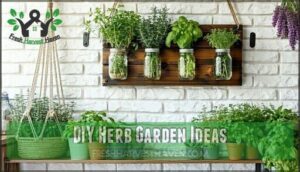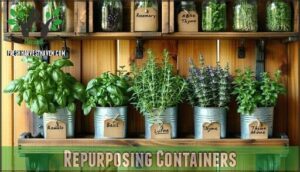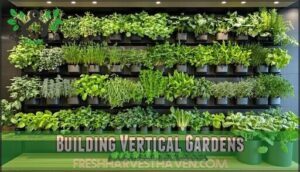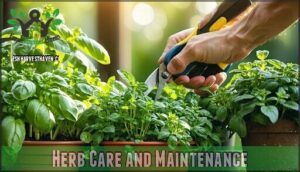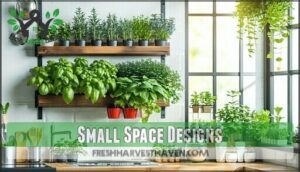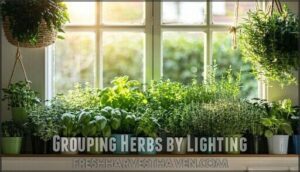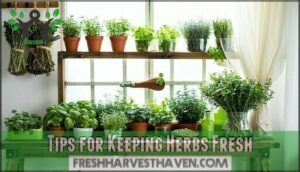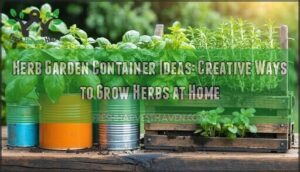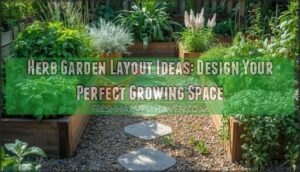This site is supported by our readers. We may earn a commission, at no cost to you, if you purchase through links.

You can transform windowsills with compact containers, repurpose mason jars for hydroponic setups, or build vertical wall gardens using pocket planters.
Countertop herb towers work perfectly for kitchens, while hanging planters utilize ceiling space efficiently.
Start with easy-growing herbs like basil, mint, parsley, and chives that thrive in various indoor conditions.
Consider grouping herbs by their water and light requirements – Mediterranean herbs prefer drier soil while leafy greens need consistent moisture.
Even the smallest apartment can accommodate a thriving herb collection with creative container solutions and proper placement strategies that’ll keep your cooking fresh year-round.
Table Of Contents
- Key Takeaways
- Benefits of Indoor Herbs
- Choosing Indoor Herbs
- Creating Herb Gardens
- Herb Care and Maintenance
- Indoor Herb Garden Designs
- Frequently Asked Questions (FAQs)
- How to grow herbs indoors?
- How do you make an indoor herb garden?
- What is the best indoor herb garden?
- How to make a simple indoor herb garden?
- Which herbs grow well indoors?
- How do I make an indoor herb garden?
- Can you have an indoor herb garden all year round?
- What herbs should not be grown indoors?
- How do you make a simple indoor herb garden?
- What herbs should not be potted together?
- Conclusion
Key Takeaways
- Start with beginner-friendly herbs like basil, mint, parsley, and chives that adapt easily to indoor conditions and forgive rookie mistakes while you’re learning proper care techniques.
- Maximize your space creatively using vertical wall planters, windowsill containers, mason jar setups, and hanging systems that transform any corner into a productive growing area.
- Group herbs by their needs – place Mediterranean varieties like oregano together in drier conditions while keeping moisture-loving herbs like parsley in consistently moist soil for optimal growth.
- Focus on proper placement and care by positioning herbs near south-facing windows, using well-draining containers, and watering when the top inch of soil feels dry to ensure year-round harvests.
Benefits of Indoor Herbs
You can transform your kitchen into a year-round herb haven that saves money while adding fresh flavors to every meal.
Indoor herb gardens offer convenience, cost savings, and the satisfaction of harvesting fresh basil, parsley, and thyme right from your countertop, providing cost savings.
Fresh Flavor and Air Quality
Nothing beats having fresh basil at your fingertips when you’re whipping up pasta sauce.
Fresh herbs at your fingertips transform every meal from ordinary to extraordinary.
Your indoor herb garden delivers Flavor Enhancement that transforms ordinary meals into culinary masterpieces, while simultaneously boosting Indoor Quality through natural Air Purification.
Here’s what your kitchen herb garden brings to the table:
- Fresh Scents that make your home smell like a Mediterranean café
- Herb Benefits including natural air filtering from plants like mint and parsley
- Zero food miles from garden to plate in seconds
- Chemical-free herbs you can trust completely
- Immediate availability for those "oops, forgot the oregano" moments
Your indoor gardening setup works double duty—enhancing both your cooking and breathing experience.
Space Saving and Cost Effective
Indoor herb gardens maximize your space while slashing grocery costs.
Vertical gardens and mini greenhouses transform unused walls into productive growing areas.
Space savers like herb shelves and compact planters fit perfectly on windowsill herb gardens or countertops, making container herb gardens accessible even in tiny kitchens.
| Space-Saving Solution | Cost Savings |
|---|---|
| Vertical wall planters | 75% less than store herbs |
| Windowsill containers | $3-5 per herb vs $2-3 weekly |
| Stackable mini greenhouses | One-time setup under $50 |
Year Round Harvest and Reduced Waste
Unlike seasonal outdoor gardens, your indoor herb garden setup delivers consistent harvests twelve months a year.
Your kitchen becomes a perpetual harvest machine, delivering fresh herbs regardless of season or weather.
You’ll slash grocery bills while eliminating the frustration of wilted store-bought herbs that spoil before you can use them completely.
Smart harvest timing and waste reduction benefits:
- Fresh picks on demand – Snip exactly what you need for tonight’s dinner
- Zero spoilage stress – No more throwing away expensive herb packages
- Continuous seasonal growth – Your basil thrives in January just like July
- Sustainable gardening wins – Reduce packaging waste from store-bought herbs
Your small herb garden becomes a reliable yearround gardening system that responds to your cooking schedule, not nature’s calendar.
By understanding optimal growing conditions, you can create an ideal environment for your indoor herbs to thrive.
Choosing Indoor Herbs
Selecting the right herbs sets the foundation for your indoor garden’s success. You’ll want to focus on varieties that adapt well to indoor conditions and match your cooking habits.
Easy to Grow Herbs
Start your indoor herb garden journey with basil, the superstar of easy herbs to grow.
This powerhouse germinates in just 5-10 days and produces fresh leaves for six months with proper basil care.
Mint adapts to containers with minimal sunlight, while chives regrow within a week of harvesting.
These growing tips make herb selection simple for beginners exploring indoor planting and garden styles.
Herbs for Partial Shade
Partial shade herbs thrive where natural light feels scarce, making them perfect shade tolerant options for your indoor herb garden ideas.
Choose parsley, chives, and lemon balm for reliable partial shade herb selections that won’t demand bright windows.
These shade herbs adapt beautifully to low light conditions, proving that successful herb garden lighting doesn’t require blazing sunshine when growing herbs indoors, and allowing for a beautiful and thriving indoor herb garden.
Herbs for Beginners
Your herb garden journey starts best with foolproof beginner herbs like basil, parsley, and mint.
These forgiving plants bounce back from rookie mistakes while you master seed starting and basic herb selection.
Focus on tender-stemmed varieties that respond well to regular harvesting, with proper basil care and simple growing tips.
You’ll quickly build confidence for more challenging herbs later, using the experience gained from growing these initial herbs, including mint.
Creating Herb Gardens
Now you can transform any corner of your home into a thriving herb paradise with simple DIY projects that require minimal investment.
Whether you’re working with a tiny apartment kitchen or have room for elaborate displays, creative container solutions and vertical growing techniques make fresh herbs accessible in any living space.
DIY Herb Garden Ideas
Creative DIY approaches transform ordinary spaces into thriving herb sanctuaries.
You’ll find endless possibilities with simple materials and clever placement strategies. Understanding soil quality importance is essential for a healthy herb garden.
- Mason jar herb garden mounted on wooden boards creates rustic charm while maximizing vertical space
- Macrame hangers suspend herb planters at varying heights, adding boho style to any room
- Wall-mounted herb shelves utilizing repurposed wood or metal brackets organize multiple varieties efficiently
- Vertical gardens built from pallets or ladder frames showcase your DIY herb garden beautifully
Repurposing Containers
You’ll find gold mines hiding in plain sight around your home.
Mason jars create charming herb gardens when mounted on walls with simple coat hooks.
Tin cans transform into labeled planters with drainage holes punched in the bottom.
Wooden crates house multiple herbs beautifully, while old pots get second lives as recycled containers.
These upcycled planters cost practically nothing but deliver professional results.
Using proper mason jar techniques can enhance your herb garden’s overall aesthetic.
Building Vertical Gardens
Moving beyond simple containers, you’ll discover that Wall Gardens and Vertical Planters transform any blank space into a thriving herb haven.
These Space Savers maximize your growing potential without expanding your footprint.
- Modular pocket systems hold up to 30 plants per square meter using lightweight felt pockets
- Self-watering vertical planters reduce maintenance by 40% with built-in drip irrigation
- LED grow lights boost herb yields by 35% when positioned on tiered racks
- Hanging herb baskets work perfectly for renters seeking removable Green Walls
- Hydroponic herb garden towers eliminate soil issues while maximizing space efficiency
Using vertical gardening systems can help optimize your herb garden’s layout.
Your vertical herb garden becomes both functional art and fresh flavor factory.
Herb Care and Maintenance
Once you’ve set up your indoor herb garden, proper care keeps your plants thriving and productive.
Regular attention to watering, feeding, and pest management guarantees a steady supply of fresh herbs for your kitchen.
Watering and Humidity
Smart watering keeps your indoor herb garden thriving.
Check soil moisture with your finger—water when the top inch feels dry.
Most herbs need consistent water levels but hate soggy roots.
Self-watering planters and smart watering systems help maintain proper humidity control.
Group humidity-loving herbs together and use pebble trays to boost moisture.
Good root health depends on balanced water schedules.
Fertilizing and Pruning
Your herbs’ appetite grows stronger with regular feeding and strategic snips. Feed them weekly with diluted liquid fertilizer—think fish emulsion or balanced plant food mixed to quarter strength.
This gentle herb fertilization guide prevents nutrient burn while boosting growth. Sharp pruning tools make clean cuts above leaf nodes, encouraging bushy development.
Pinch flowers immediately to maintain leaf flavor and extend harvest timing. Regular trimming keeps plants compact and productive, turning your windowsill into a thriving herb factory.
Common Pests and Solutions
Proper watering and feeding set your herbs up for success, but even healthy plants face unwelcome visitors. Aphids target basil and mint, sucking sap and weakening growth. Spider mites create fine webbing on leaves, while fungus gnats multiply in moist soil.
Early pest identification prevents major infestations and protects your harvest. Effective common pest control methods can help mitigate these issues.
- Aphid Control: Spray insecticidal soap or neem oil for 85% population reduction within three applications
- Whitefly Management: Use sticky yellow traps to catch 75% of adults and prevent leaf damage
- Fungus Prevention: Allow soil to dry between waterings and add sand layer to reduce gnat emergence by 65%
- Organic Remedies: Remove mealybugs with rubbing alcohol on Q-tips or rinse spider mites with water streams
Indoor Herb Garden Designs
You’ll want to match your herb garden design to your living space and lighting conditions.
Smart placement and grouping strategies will help your herbs thrive while creating an attractive kitchen display.
Small Space Designs
Cramped kitchens don’t have to cramp your style.
Wall planters and wall-mounted herb shelves transform vertical space into green real estate.
Mini greenhouses fit snugly on countertops, while space-saving vertical gardening systems stack herbs like building blocks.
An indoor herb garden kit eliminates guesswork for small space gardening newcomers.
Herb shelves maximize every inch without sacrificing function.
Effective use of indoor herb planters can greatly enhance the overall aesthetic and functionality of the space, making small space gardening more efficient.
Grouping Herbs by Lighting
Maximizing your indoor herb garden ideas starts with matching plants to their lighting needs.
Sun loving herbs like basil and oregano thrive with bright herb gardens receiving 6+ hours of direct light, while shade tolerant varieties like parsley and mint flourish with just 3-5 hours.
LED grow lights bridge gaps where natural light falls short, making lowlight gardening possible anywhere indoors.
Understanding optimal growth conditions is essential for a successful indoor herb garden with optimal growth.
Tips for Keeping Herbs Fresh
Perfect harvest timing makes all the difference for your indoor herb garden.
Pick herbs early morning when essential oils peak for maximum flavor. Store fresh-cut herbs in water like flowers, covering leaves with plastic bags.
For herb preservation, dry excess harvests by hanging bundles in cool, dark spaces. Control moisture by patting herbs dry before refrigerating.
Proper herb garden care extends shelf life substantially. Regular indoor plant maintenance and smart herb growth tips keep your herb freshness lasting weeks longer.
Frequently Asked Questions (FAQs)
How to grow herbs indoors?
Picture herbs thriving on your sunny windowsill, their fragrant leaves reaching toward warm light.
Choose well-draining pots with drainage holes, place near south-facing windows, and water when soil’s top inch feels dry.
How do you make an indoor herb garden?
Choose containers with drainage holes, add potting soil, and plant beginner-friendly herbs like basil, parsley, or mint.
Place near a sunny south-facing window and water when soil’s top inch feels dry.
What is the best indoor herb garden?
You’ll find success with self-watering planters or smart garden kits that include grow lights.
These systems handle watering schedules and provide consistent lighting, making herbs like basil, parsley, and chives thrive indoors year-round with consistent lighting.
How to make a simple indoor herb garden?
Creating your own green oasis starts with selecting a sunny south-facing window and well-draining containers.
Plant beginner-friendly herbs like basil, parsley, and mint in quality potting mix, water when soil’s top inch dries, to ensure a thriving and healthy oasis.
Which herbs grow well indoors?
Basil, parsley, chives, thyme, oregano, and mint thrive indoors with proper light. You’ll find cilantro, lemon balm, and rosemary also adapt well to container growing when given bright, south-facing windows.
How do I make an indoor herb garden?
Unlike store-bought herbs that wilt within days, you’ll create a thriving kitchen garden that delivers fresh flavor year-round.
Start with well-draining pots, quality potting mix, and beginner-friendly herbs like basil and parsley near your brightest window.
Can you have an indoor herb garden all year round?
Yes, you can maintain an indoor herb garden year-round with proper setup.
Unlike outdoor gardens limited to growing seasons, indoor herbs thrive continuously with adequate light, drainage, and care throughout all seasons.
What herbs should not be grown indoors?
Most herbs aren’t suited for indoor growing due to space or light requirements. Avoid large herbs like fennel, angelica, and lovage. Skip sun-hungry Mediterranean varieties like lavender in low-light homes.
How do you make a simple indoor herb garden?
Creating your personal herb sanctuary starts with choosing a sunny south-facing window.
Place well-draining pots with beginner herbs like basil, parsley, and mint.
Water when soil’s top inch feels dry, fertilize monthly.
What herbs should not be potted together?
You shouldn’t plant lavender and basil together because they’ve conflicting water needs—lavender prefers dry soil while basil thrives in moisture. Similarly, avoid pairing Mediterranean herbs with moisture-loving varieties.
Conclusion
Picture your kitchen countertop dotted with vibrant green herbs, their fresh scent greeting you each morning.
These indoor herb garden ideas transform any space into a productive mini-farm that’ll elevate your cooking year-round. You’ve got everything from windowsill containers to vertical wall gardens that maximize every inch.
Start with beginner-friendly herbs like basil and parsley, then expand your collection as you gain confidence. With proper placement and care, you’ll enjoy fresh flavors while reducing grocery costs and waste, which is a key aspect of having an indoor herb garden for year-round use.


